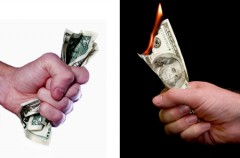Tightwads, Spendthrifts, and Everyone Else
 Marketers love to segment their potential customers, and now there’s a new way to do it: spendthrifts, tightwads, and everyone else. Research at Carnegie Mellon University shows that 40% of consumers can be classified as either spendthrifts or tightwads, while 60% fall into a middle category without strong tendencies in either direction. Furthermore, this behavior is related to one of our favorite neuromarketing topics, buying pain.
Marketers love to segment their potential customers, and now there’s a new way to do it: spendthrifts, tightwads, and everyone else. Research at Carnegie Mellon University shows that 40% of consumers can be classified as either spendthrifts or tightwads, while 60% fall into a middle category without strong tendencies in either direction. Furthermore, this behavior is related to one of our favorite neuromarketing topics, buying pain.
|
Tightwad – Spendthrift Series
|
| Tightwads, Spendthrifts, and Everyone Else |
| Find Out If You Are A Tightwad |
| Five Keys to Selling to Tightwads |
| Five Keys to Selling to Spendthrifts |
A fascinating paper, Tightwads and Spendthrifts, published earlier this year by Scott I. Rick, Cynthia Cryder, and George Loewenstein (all of CMU), describes the survey that was used to characterize the different groups of spenders and even validates a set of survey questions designed to identify which group an individual falls into. Simply put, some individuals feel so much buying pain that they tend to avoid spending money even in situations where most individuals would find the expense to be justified and of good value; these are “tightwads.” “Spendthrifts,” meanwhile, seem to feel little buying pain, and spend money even in situations where most individuals would avoid doing so.
According to the researchers, the differences in behavior between the two groups are strongest in scenarios where the pain of paying is maximized (e.g., immediate payment in full) and smallest in situations with the least buying pain (e.g., payment deferred into the future). They also find a distinction between tightwads and people who are frugal. Frugal people don’t feel more buying pain than the rest of us, they simply enjoy saving. That distinction may be inconsequential in some situations, but it’s important to note that the underlying motivation of frugality is different.
A survey of more than 13,000 individuals showed the following breakdown:
Tightwads – 24%
Unconflicted – 60%
Spendthrifts – 15%
Some marketers may be disappointed that free spenders comprise only 15% of their potential customer base, but the key takeaway is that there are major portions of the population who are wired to respond to marketing offers in quite different ways. Ignoring these differences may result in an underperforming ad campaign or sales effort.
One of the defining questions in the survey was how much credit card debt the subject had. Spendthrifts were three times as likely as tightwads to have credit card debt. Perhaps unsurprisingly, tightwads reported higher levels of personal savings than spendthrifts.
We’ll look at some of the marketing implications of these differences in future posts. Clearly, each group may have some “hot buttons” that work better than others. While an in-person sales effort can adjust to customer characteristics on the fly, print and other media campaigns may have to come up with an approach that is geared to the most likely buyer groups, or develop somewhat different campaigns if it makes sense to try to target all groups of customers. One approach that seems likely to work across the board is to minimize buying pain in a given offer – that shouldn’t hurt performance with spendthrifts, who feel little pain anyway, but will help with the unconflicted group and in particular the tightwads. (Then again, one would argue that minimizing buying pain is always a good idea, even without this research data.)
(Via A little about anything and Knowledge@Wharton.)
